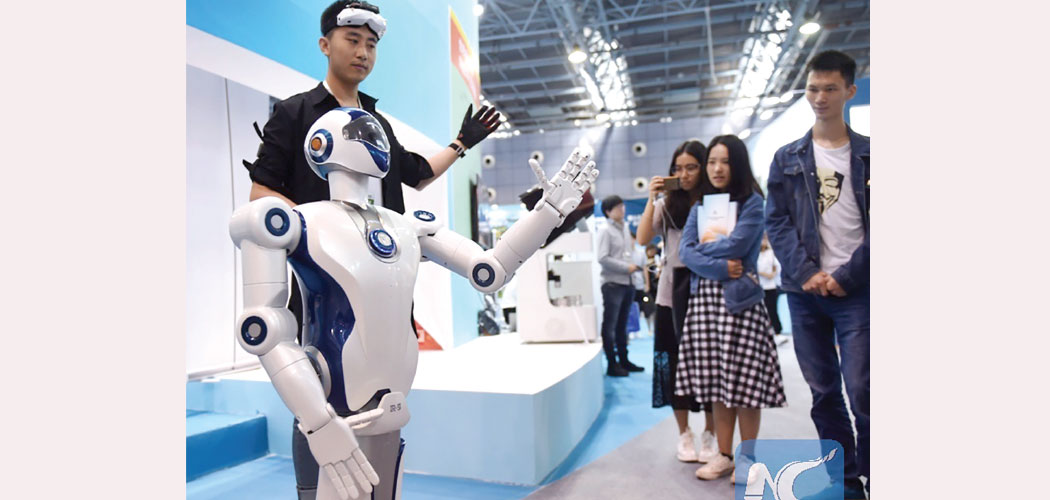- Monday, 15 December 2025
The Robotics Revolution Of China
Staying on the 16th floor of the Holiday Inn Express Hotel at Jiaoqiao Road in the Pu Dong New Area of Shanghai, this scribe thought that making room deliveries for the hotel guests must be a slow and difficult task. It potentially demanded the employment of a sizable number of human resources at a time when labour costs have been sharply rising in China in recent years. “Labour in China used to be cheap, a factor that attracted both domestic and foreign companies to invest in labour-intensive assemblage and processing ventures,” says Zhuang Rui, Professor of International Economic Research Inistitute at the University of International Business and Economics (UIBE) based in the Chinese capital, Beijing. But lately, according to Professor Zhuang, labour costs are no longer cheap in China. For example, back in 2006, a labourer could be hired at the wage of 7 yuan per hour. That wage has now climbed to 45 yuan per hour. A housekeeping labourer in Beijing has to be paid a minimum salary of 1560 yuan per month, which can go higher based on the skills and experience of the worker.
Running out of the bottled mineral water in the room, I dialled the reception front desk of Holiday Inn Express and made an order for three bottles of drinking water. Minutes later, I receive a callback ring in the room phone. There was the automated voice message on the phone about the delivery of the water outside the room. I opened the door and could see no presence of human staff delivering the water. Instead, to my astonishment, there was a robot, about two and a half feet tall, standing just outside the door. I could see three bottles of mineral water, which I had ordered, inside the glass chamber of the robot, but the chamber was closed. On the upper side of the robot, I see a touch-screen button with the word “Open”. The chamber opened as soon as I touched the button, and then I collected my water.
The robot returns with ‘Thank you’ toward the elevator. The mechanical worker is pre-programmed in such a way that sensors are at play to open the elevator door upon the approach of the robot to and from its service destination. The machine can be seen waiting around the lobby when it is not working. If it ‘sees’ a person right on its path while moving along the passage, it stops until the way is clear. And when it runs out of battery charge, it goes to the assigned charging station and charges itself.
During a tour of ZD Energy, a company specialising in smart electric vehicle (EV) charging systems in Shanghai, China, visitors from around the world, including Nepal, were shown a variety of charging devices meant both for private homes and public places. One of the innovative technologies on display was the EV charging robots that make human jobs much easier with their efficiency to operate in extreme temperature conditions ranging from minus 10 degrees to 50 degrees Celsius. These technologically boastful charging robots are used in high-traffic areas like airports and public bus stations.

ZD Energy officials said that the company is making a green energy revolution by providing cleaner alternative solutions to reverse the carbon footprints caused by the use of fossil fuel vehicles. “This is the age of EV, and we are making clean energy footprints with our green and sustainable transportation technologies. We are the key enabler of the e-mobility revolution and number one EV charging supplier,” said Alison Zhang, Head of Marketing and Communications at ZD Energy. The company’s Overseas Business Development office based at Shanghai’s KIC Technology Centre said that it has shipped 1.6 million EV chargers worldwide, with approximately 300 charging devices already installed in Nepal.
Since the opening up and economic reforms policy adopted by China from the late seventies, Shanghai has turned into a hub for foreign investors and manufacturing companies, many from the United States of America. The trade connection between China and the US is so immense that President Trump’s aggressive tariff strategy has started to stagger and fail. Elon Musk’s Tesla company opened its EV manufacturing plant in Shanghai in 2019. The EV boom with the establishment of Tesla’s manufacturing plant has brought new prospects for the EV recharging makers of China, like ZD Energy. “We are working with over 70 vehicle brands, and the coming of Tesla in Shanghai has opened new business opportunities for us,” said an official at ZD Energy.
A recent visit to Shanghai and Beijing in the People’s Republic of China gave an opportunity to observe firsthand the revolution taking place in the field of robotics and automation there. Applications of artificial intelligence (AI) and the Internet of Things (IoT) are making drastic transformations in the ways work is carried out in everyday life. The miracle of sci-tech advancements can be seen in a myriad of areas—from agriculture to space science, auto manufacturing to electronic recycling, and EV charging to e-commerce.
When a foreigner visits China, there is a language barrier to communicate smoothly with a hotel receptionist, restaurant waiter or a taxi driver. Sign boards written in English can be seen in a very small number, and the menu at a restaurant comes in the Chinese language. When I asked in English the front desk man at Beijing Orange Hotel near UIBE in Chaoyang District, he held out his mobile phone and asked me to speak again so that his AI translator app could convey to him what I was trying to say. I had an inquiry about the nearest shopping place in the vicinity.
China has opened up for business, trade and diplomacy, but a limitation to the English language still remains. But this barrier is being broken by the AI-driven translation apps these days, though Google does not function in China. For anyone visiting China, installing a functional translation app is highly recommended. Twenty-five-year-old, Chen Jun Liang, says there is a good scope for working as an interpreter, and he is studying English at UIBE with this aim.
When we visited Shanghai’s Zhangjiang Robot Valley during a tour managed by the UIBE international seminar organising team, we were awestruck by the wide range of robots on display in a large exhibition hall. A lady host was briefing us in standard English. There were robots that performed medical surgery in high radiation where doing the job by humans can be hazardous. There also were robotic gloves used to conduct medical tests and educational robots for kids’ entertainment and learning purposes. Other robots were for bulk load handling, undersea exploration and automobile manufacturing. There was one that could look at your face and draw a pencil sketch. We were amazed to see the robot make a pencil sketch of our friend Yubaraj Gautam within a matter of minutes and deliver.

















